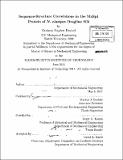Sequence-structure correlations in the MaSp1 protein of N. clavipes dragline silk
Author(s)
Bratzel, Graham Hayden
DownloadFull printable version (13.86Mb)
Other Contributors
Massachusetts Institute of Technology. Dept. of Mechanical Engineering.
Advisor
Markus J. Buehler.
Terms of use
Metadata
Show full item recordAbstract
Silk is a hierarchically structured protein fiber with exceptional tensile strength and extensibility, making it one of the toughest and most versatile biocompatible materials. While experimental studies have shown that the molecular structure of silk has a direct influence on the stiffness, toughness, and failure strength of silk, few molecular-level analyses of the nanostructure of silk assemblies, in particular under variations of genetic sequences, have been published. Here, atomistic-level structures of wildtype as well as modified MaSp1 protein from the N. clavipes spider dragline silk sequences are reported, obtained using an in silico approach based on replica exchange molecular dynamics (REMD) and explicit water molecular dynamics. In particular, the atomistic simulations discussed in this parametric study explore the effects of the poly-alanine length of the N. clavipes MaSpi peptide sequence, solvent conditions, and nanomechanical loading conditions on secondary and tertiary structure predictions as well as the nanomechanical behavior of a unit cell of 15 strands with 900-1000 total residues used to represent a cross-linking 7-sheet crystal node in the network within a fibril of the dragline silk thread. Understanding the behavior of this node at the molecular scale is critical for potentially bypassing strength limits at this length scale and vastly improving silk for medical and textile purposes as well as synthetic elastomers and polymer or aramid fiber composites with a similar molecular structure and noncovalent bonding for aerospace, armor, and medical applications. The main hypothesis tested is that there exists a critical minimum length of the poly-alanine repeat that ensures the formation of a robust cross-linking the [beta]-sheet crystal. Confirming earlier experimental and computational work, a structural analysis reveals that poly-alanine regions in silk predominantly form distinct and orderly [beta]-sheet crystal domains while disorderly regions are formed by glycine-rich repeats that consist of 310-helix type structures and 7-turns. These predictions are directly validated against experimental data based on dihedral angle pair calculations presented in Ramachandran plots combined with an analysis of the secondary structure content. The key results of this study are: e A strong dependence of the resulting silk nanostructure on the poly-alanine length. The wildtype poly-alanine repeat length of six residues defines a critical minimum length that consistently results in clearly defined [beta]-sheet nanocrystals allowing for misalignment. For poly-alanine lengths below six residues, the /-sheet nanocrystals are not well-defined or not visible at all, while for poly-alanine lengths above six the characteristic nanocomposite structure of silk emerges with no significant improvement of the quality of the sheet nanocrystal geometry. A simple biophysical model is presented that explains the minimum length scale based on the mechanistic insight gained from the molecular simulations. The efficient stacking of the [beta]-sheets of a well-defined crystal reinforces local hydrophobicity and prevents water diffusion into a crystal above a critical size. Nanomechanical testing reveals that the combination of the 12-alanine length case and central pull-out loading conditions results in delayed failure by employing a hierarchy of strong [beta]-sheets and soft, extensible semi-amorpous regions to overcome a predicted H-bond saturation. This work constitutes the most comprehensive study to-date of the molecular structure prediction and nanomechanical behavior of dragline silk. Building upon previous computational studies that used similar methods for structure prediction and mechanical analysis, e.g. REMD and force-control loading, this work presents: the first results of the near-native structures determined by REMD after equilibration in TIP3P explicit solvent, the first parametric study of the effects of modifying the wildtype poly-alanine segment length to values outside the range naturally observed for MaSp1 on structure prediction and nanomechanical behavior, and, the first comparison between previously published loading conditions, i.e. the Stretch test, and the novel Pull-out loading conditions that are hypothesized to be more appropriate for modeling of the in situ loading of the cross-linking [beta]-sheet crystal. Further parametric studies in peptide sequence to optimize bulk fiber properties must involve changes in simulated nanomechanical loading conditions to properly assess the effects of the changes in peptide sequence. These findings set the stage for understanding how variations in the spidroin sequence can be used to engineer the structure and thereby functional properties of this biological superfiber, and present a design strategy for the genetic optimization of spidroins for enhanced mechanical properties. The approach used here may also find application in the design of other self-assembled molecular structures and fibers and in particular biologically inspired or completely synthetic systems.
Description
Thesis (S.M.)--Massachusetts Institute of Technology, Dept. of Mechanical Engineering, 2011. Cataloged from PDF version of thesis. Includes bibliographical references (p. 77-86).
Date issued
2011Department
Massachusetts Institute of Technology. Department of Mechanical EngineeringPublisher
Massachusetts Institute of Technology
Keywords
Mechanical Engineering.